Getting into the garlic groove
I’ve been a happy garlic gardener for maybe 10 years now. I’ve found it to be among the easiest, most reliable things one can plant. Prep a bed, stick cloves in around October (more or less), keep the weeds down come spring, harvest and enjoy!
We eat green garlic in April and May, and cook with the scapes once they emerge. Lately I’ve been letting some scapes develop into bulbils for another method of propagation. (As pictured above, homegrown from red garlic.)
So far my garlic has only been prone to one pest. Worst case scenario, about 1/3rd of my crop is marred by the hard-to-see insect critters, as evidenced by tunnels in the leaves and scapes. I don’t use pesticides, so I just rotate where I plant and live with some loss.
I usually manage to grow enough to replant and supply household demand until next spring. And give some away. (But that can get tricky because that demand always outstrips supply!) Fresh, tasty, organic, economical and good for you. Go garlic!
Back in May of 2011 we moved from the wee village of Kars to the bustling metropolis of near-by North Gower. Thanks to physically leaving my old garden behind, I had to skip a crop and replant. Given the excuse to branch out, I ordered a number of fun varieties from a Canadian source called Boundary Garlic Farm. They’re out in British Columbia, but in a zone that’s even colder than Ottawa, so I though ordering from them would be safe.
The imports did well enough. Last year was terribly dry and we only had enough well water for the main garden. Outliers fared less well in the baked-to-dust earth. Amazingly, everything survived, although the driest plots were pitifully withered.
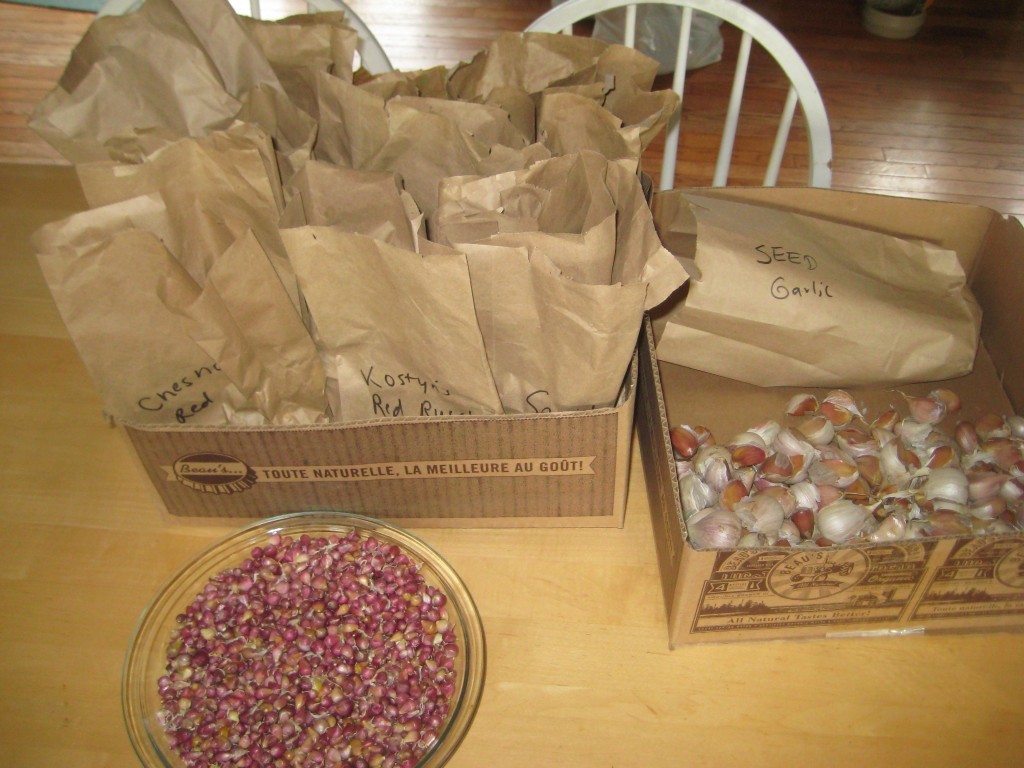
Drought made 2012 tough on gardens. Thankfully, enough home-grown garlic came through to re-plant in October. (photo by L. Martin)
Most sources will not ship garlic across the border (soil borne diseases being one concern) so don’t even try. But I call the B.C. farm to American attention anyway because their website is excellent. It shares lots of info on different varieties, on growing cloves the conventional way and on starting garlic with bulbils, including a lovely photo gallery.
Bulbils are what form on scape head (pod?) if left to fully develop. Ted Maczka (“the Fish Lake garlic man”) gave a talk on propagating bulbils at the Perth Garlic Festival back in 2011. The second photo show bulbils he’s sized up once.
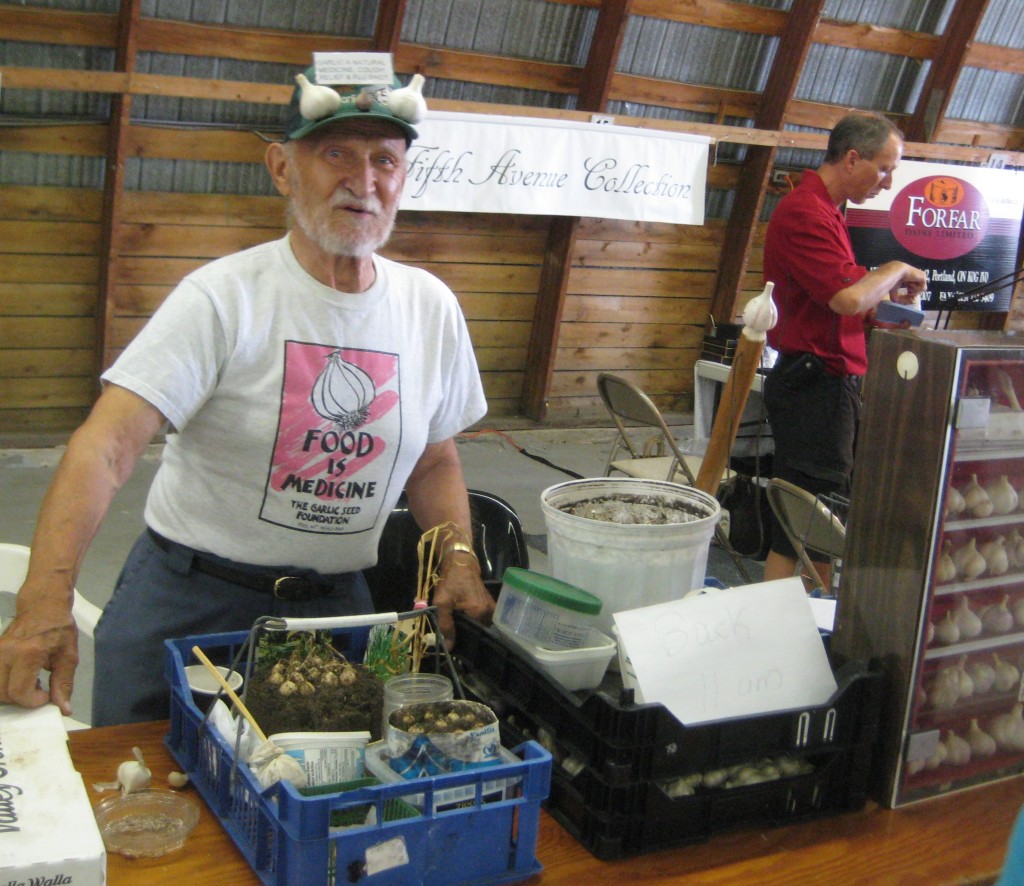
Ted “Fish Lake Garlic Man” Maczka explained bulbil propagation at the Perth Garlic Festival in 2011. (photo by L. Matin)
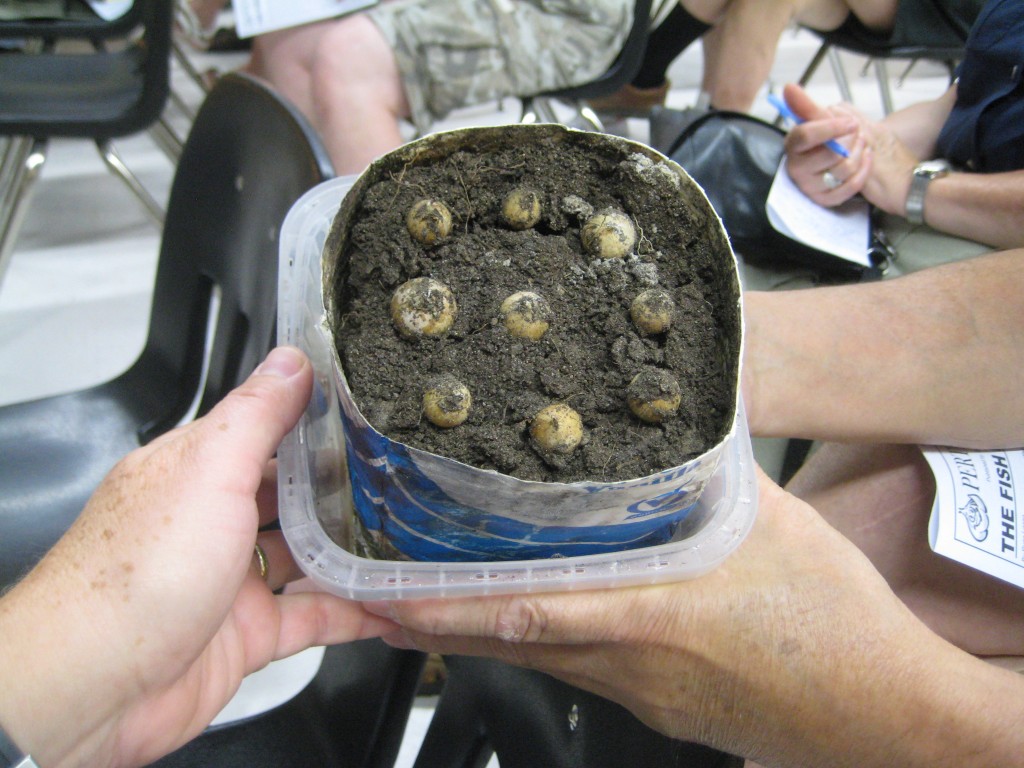
Maczka’s demonstration display of bulbils at what I call “the pearl onion size stage” – plant these out one more time to reach full size. (photo by L. Martin)
I think the first-time-grown bulbils look like pearl onions. Just like regular garlic, these will go dormant. Harvest and plant them one more time and they’ll turn into full-size bulbs.
Yes, this takes longer. But this method provides for a fabulous multiplier effect. (I’ll know more about how this works next year. I am only half-way through my first try at doing this.) By starting with bulbil propagation growers can also avoid spreading soil-borne diseases.
I’m thinking about garlic right now because of a library book I’ve been reading this week: “The Complete Book of Garlic: A Guide for Gardeners, Growers and Serious Cooks” by another Ted, Ted Jordan Meredith (Timber Press, 2008). Meredith has a good blog on garlic too.
By the way, the term “seed garlic” is a bit misleading. Like seed potatoes, it refers to propagation material grown for that purpose, not actual seeds. It is possible to produce true garlic seeds, but it takes special effort and is seldom done. (Read more about true garlic seed at Meredith’s blog.)
Alas, I’m not the sort of gardener who knows the Latin names, or remembers all the technical stuff. But this book has all that and more.
Garlic is a good crop for this part of the world. If you’ve been thinking about it, but are put off by trying something unknown, I say take the leap. Here’s more from Cornell’s vegetable growing guide on garlic.
Looking around to see if there was anything related to garlic happening in Northern New York in March, I stumbled on something called 2013 Capital District Garlic School, happening in Geneva, N.Y. on March 19th, sponsored by Cornell Cooperative Extension. It seems geared for growers more than gardeners, but I’m sure they’d be happy to see any interested party. (Small fee, pre-registration deadline is Mon. March 18.)
One of my old neighbors in Kars lost an entire crop to rot in a wet year. So aim for good drainage, or use raised beds.
On the other hand, a small farm that grows market vegetables on the outskirts of North Gower, was totally under water – for days! – in last year’s spring thaw. I was sure they would lose all their garlic, yet it came through alright. Go figure!
I’ve been throwing lots extra details into this post – but you can always keep it super simple.
Bottom line: garlic is worth trying!





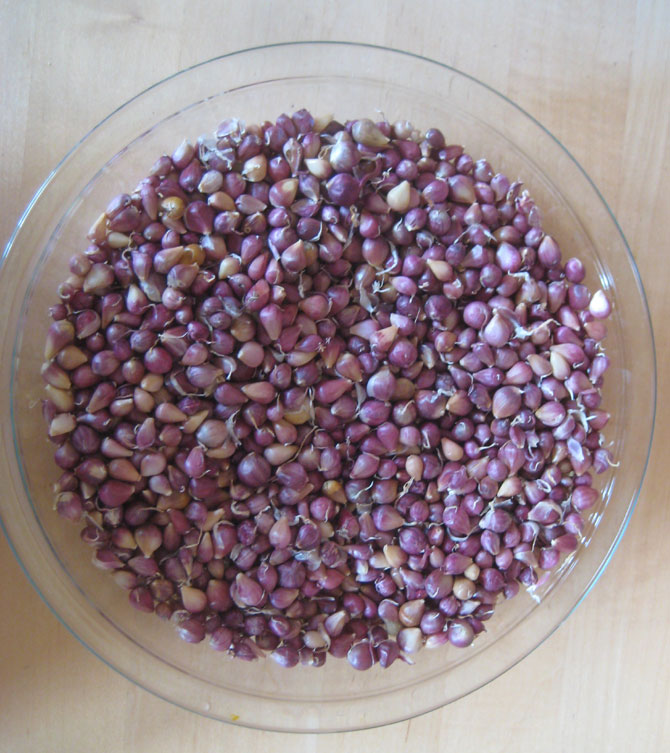
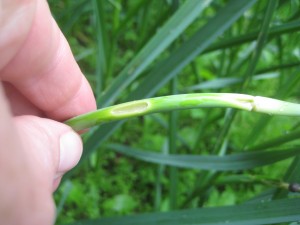



Now, here’s the question: can you put too much garlic in a soup or stew or sliced on the top of a pizza or diced into a salad? There seem to be two schools of thought about garlic: use one clove or less vs. use the whole head. I come from the whole head school. I mean, once you’ve broken out a clove or two for the stew, what the heck, you might as well throw in the rest of it, eh?
Roasting whole heads of garlic the Spanish way: pour a box of coarse salt (canning or kosher) into a loaf bread pan, then bury whole heads of garlic in the salt and bake for about 30-45 minutes in a 350F oven. Save pan of salt for the next batch of roasting.
We once made garlic ice cream for the garlic festival at the Chateaugay Lakes farmers market. Pretty good.
I’m of the whole head persuasion, and can make up a pretty fine red sauce with only garlic and tomatoes in the time it takes to heat water and cook noodles.
We’ve been planting from our own stock for a good long time, and over the last few years, I’m getting more and more heads with larger cloves, and multiple cloves in each segment. It stores just as well, and makes for a lot less peeling. Is anyone else seeing this?
Thanks for the Spanish roasting tip Ellen.
Every single garlic festival I’ve been to in Canada that offers garlic ice cream doesn’t have enough to meet demand. It always sells out – with hours left to go in the event. Perhaps that’s intentional. Maybe you can’t sell that flavor outside a garlic festival? (And can’t store leftovers of something so pungent next to other flavors of ice cream?)
Much as I love garlic, there are lots of people who dislike it. The “can’t stand the stuff” population seems high where I live now (Ottawa region). I’ve been to pot luck gatherings, for example, where early party goers will caution new arrivals “Say, watch out for *that* dip, it’s got garlic!” 7 out of 10 will say “Oh, thanks for the warning, I’ll avoid it!” The other 3 (plus me) go scoop it up! I’m usually thinking “Why this barely has any garlic at all, what’s to be frightened of?”
As for Michael’s question about larger cloves, I am growing all new stock and won’t be able to judge that for some years. Several of the resource books and sites I’ve read say garlic needs to adapt (and will adapt) to specific sites. Though I am not sure how much flavor and bulb size would change along the way, if any.
One of the Ontario growers at the 2011 Perth Garlic Festival (whose name I have since forgotten) said garlic is all about the soil it is grown in. After a while, he said, even different varieties will taste the same.
Not sure that’s true. (I don’t want that to be so!) But that’s what one experienced grower thought. I am hoping he only grew a few already-similar types, and that’s why his began to seem alike over time.